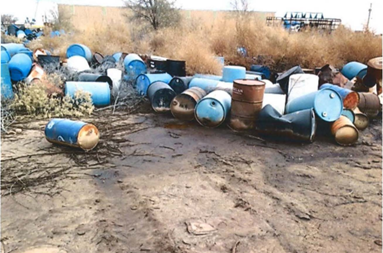Drum Reconditioner Damage Case Report
On this page:
- EPA's Damage Case Report
- Resource Conservation and Recovery Act (RCRA) Regulations
- About Drum Reconditioners
- Drum Reconditioners by State
- Related Resources

EPA's Damage Case Report
EPA completed a damage case report (pdf)(1.4 MB) to improve our understanding of how the drum reconditioner industry operates and to document damage case incidents at these facilities that have caused damage to human health and the environment. This report serves to inform domestic policymakers, enforcement officials, and the public about the regulatory and waste issues surrounding drum reconditioning facilities. EPA is planning to engage interested entities on possible approaches to addressing and mitigating these issues.
EPA compiled and analyzed information from publicly available sources on drum reconditioning facilities and their damage cases, which included EPA online databases, public complaints and concerns, newspaper articles, and other government agency reports, including state environmental agencies. The goal of the report is to increase awareness of interested entities of this critical topic. EPA will engage interested entities on ways to tackle these issues, particularly on methods to prevent future damage to human health and the environment from drum reconditioners.
The report's findings indicate an estimated national drum reconditioning universe of 181 facilities with approximately 40 million total drums being processed each year. The data also indicate that approximately 35% of drums are reconditioned using burn-off ovens, and the remaining 65% are reconditioned through washing methods.
Of the total 181 drum reconditioning facilities identified by EPA, 86 had one or more reported damage cases, representing 47.5% of the industry. Damages include fires; drum explosions; hazardous waste spills; improper storage of drums; employee injuries; air, water, or soil contamination; and various combinations of these incidents.
Drum Reconditioner Damage Case Report (pdf)
RCRA Regulations
The RCRA empty container provision is found in Title 40 of the Code of Federal Regulations in section 261.7. This provision exempts from regulation hazardous waste residues that remain in a drum or other container, as long as certain conditions are met (e.g., all wastes have been removed using commonly employed practices and no more than one inch of non-acute hazardous waste remains in a drum). Despite this exemption, drum reconditioners are still receiving non-empty containers and, as such, are likely accepting many drums of hazardous waste that are not actually "RCRA empty." As a result, these facilities are potentially managing large quantities of hazardous waste without a provision in the regulations that allows drum reconditioners to store rejected non-empty hazardous waste containers and without being subject to substantive RCRA hazardous waste regulations.
About Drum Reconditioners
Drum reconditioning facilities clean and recondition metal and plastic drums and intermediate bulk containers for resale and reuse by cleaning, restoring, testing, and certifying these industrial containers. These containers previously held a variety of materials including hazardous chemicals, paints, resins, tars, adhesives, oils, soaps, solvents, or related materials. The two main processes used for reconditioning are:
- Burning off residuals from metal drums in a burn-off oven or furnace.
- Washing metal or plastic drums or containers with water and/or a caustic solution to clean out residues.
Drum Reconditioners by State
Are there drum reconditioners in your state? Check out the report’s Appendix B, sorted by state (pdf)(1.1 MB), to find out.
Note: EPA acquired this data from publicly available online resources. If you have any additions or corrections, please contact Franssen.Kaitlin@epa.gov.
